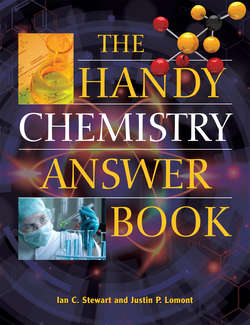Читать книгу The Handy Chemistry Answer Book - Justin P. Lomont - Страница 34
На сайте Литреса книга снята с продажи.
REACTIONS OF ORGANIC COMPOUNDS
ОглавлениеWhat are “curved arrows” in organic chemistry?
Chemists used curved arrows to depict the flow of electrons in a chemical reaction. The arrow starts at the nucleophile (a lone pair of electrons, a π bond, or a σ bond), and points toward the electrophile (an atom, or bond, with a full or partial positive charge). Here’s an example of a transesterification reaction (i.e., changing one ester for another).
What is a nucleophile?
A nucleophile is a molecule that donates electrons (to an electrophile) in a chemical reaction. These are typically functional groups with lone pairs of electrons, but can also be π bonds, or, in some rare cases, σ bonds.
What is an electrophile?
Electrophiles are species that accept electrons (from a nucleophile) in a chemical reaction. Usually, electrophiles have either a full- or partial-positive charge, or in some cases (like BH3) have an unfilled octet of electrons.
What is a substitution reaction?
The exchange of one functional group, or atom, for another is called a substitution reaction. The transesterification reaction above is an example of substituting a -OCH2CH3 group for a -OCH3 group. Another simple substitution reaction is the exchange of one halogen for another on a methyl group:
What is a unimolecular substitution reaction?
We’ve already talked about substitution reactions, so what makes one “unimolecular”? If the transition state (remember, this is the highest energy state of an individual chemical reaction) involves one (uni-) molecule (-molecular), then it is referred to as a uni-molecular reaction. This might seem like an odd thing to distinguish, but there are many differences between uni- and bimolecular substitution reactions. These differences all result from how many species are involved in the transition state.
For an example, here’s the reaction of tert–butyl chloride with hydroxide ion:
The first step is breaking the C–Cl bond, and this involves only the (CH3)3C–Cl molecule. Then the hydroxide ion reacts with the tert–butyl carbocation in the second step. Since there is only one molecule in the slower first step (just assume that’s true so we can illustrate this point), this is a unimolecular substitution reaction.
What is a bimolecular substitution reaction?
From the last answer, you can probably guess that a bimolecular substitution reaction has two (bi-) molecules (-molecular) in the transition state. This means that the slowest step involves two molecules interacting. In the previous example, there was only one.
Let’s look at a similar substitution reaction, but instead of tBuCl, we’ll react hydroxide with MeCl:
Here the nucleophile (OH−) directly displaces the leaving group (Cl−), without forming a carbocation intermediate. This is because the methyl cation (CH3+) is much less stable than the tert–butyl carbocation formed in the previous question.
Why are more substituted carbocations more stable?
Great question! First, let’s review what led you to this question. In the unimolecular substitution reaction we looked at, an intermediate tert–butyl cation was formed, but in the bimolecular substitution reaction, the cation (this time a methyl cation, CH3+) was too high in energy. In this case the hydroxide ion directly displaced the chloride ion.
Generally, the more highly substituted a carbocation is, the more stable it is. There are a number of ways to explain why this is true. The first is that carbon substituents are more electron-donating than hydrogen atoms. Electrons on neighboring carbon atoms can help stabilize the cationic center. Simply put, the order of carbocation stability matches the number of carbons bonded to the cationic carbon, with higher numbers leading to greater stability.
What is hyperconjugation?
Hyperconjugation is another way to explain why substituted carbocations are more stable. The electrons in either the C–C or C–H bonds that are near the cationic center can interact with the empty p-orbital. It’s not the bonds that are directly connected, but rather one bond removed from the center carbon, that are the most important (see the illustration below). At the simplest level, this provides an explanation for the statement in the previous answer that neighboring carbon atoms are more electron-donating than hydrogen atoms: it’s really the neighboring C–H bonds that help stabilize the empty p-orbital.
Note: The arrow above is just to illustrate the overlap of the C–H σ bond with the empty p orbital. It’s not to suggest that the hydrogen atom actually moves…though this does happen sometimes!
What is an addition reaction?
In an addition reaction, two or more molecules combine to make one molecule. This is different than the substitution reactions we have been looking at, where two molecules combine to make two different molecules.
The addition of an acid to an alkene is the simplest example. Here, an acid proto-nates a carbon–carbon double bond. The carbocation that is formed will be the more substituted one of the possible products that could form. The conjugate base of the acid then reacts with this carbocation.
